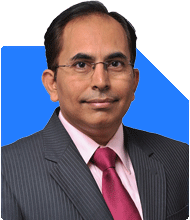Ramalingam Kalirajan |10870 Answers |Ask -Follow
Mutual Funds, Financial Planning Expert - Answered on May 18, 2024
He has an MBA in finance from the University of Madras and is a certified financial planner.
He is the director and chief financial planner at Holistic Investment, a Chennai-based firm that offers financial planning and wealth management advice.... more

Hi , My age 47 yrs. started SIP in 2010 after watching CNBC TV started with 3000 in 3 fund and increased to 63000 in 16 fund for me and my wife. Accumulated 1 CR. till now. For my son education I Need 25 lac every year for 5 years from next year. I kept 5 lac emergency fund. PPF for family is 1.1 CR. No Fixed deposit. I have adequate Term and health Insurance. Equity 10 lac. Should I withdraw money from MF and put in FD or wait till next year considering volatility in market ?
Congratulations on achieving a significant milestone with your mutual fund investments! Let's assess the best approach for funding your son's education while considering the current market volatility.
Current Financial Position
Investment Success
Accumulating ?1 crore through SIPs demonstrates your disciplined approach and ability to build wealth over time.
Emergency Fund
Maintaining a ?5 lakh emergency fund ensures financial security and provides a safety net during unexpected situations.
PPF Investment
Your substantial PPF investment of ?1.1 crore indicates a long-term savings strategy for future needs.
Funding Son's Education
Financial Requirement
Requiring ?25 lakh annually for your son's education for 5 years presents a significant financial commitment.
Withdrawal Consideration
Evaluate the pros and cons of withdrawing from mutual funds versus maintaining investments given the current market volatility.
Assessment of Options
Pros of Withdrawing from MFs
Immediate access to funds for your son's education without relying on loans or other sources.
Certainty of having the required amount available when needed.
Cons of Withdrawing from MFs
Potential loss of future returns if the market recovers and investments perform well.
Disruption to long-term investment strategy and financial goals.
Considering Market Volatility
Short-Term Impact
Market volatility may affect the value of your mutual fund investments in the short term.
Long-Term Perspective
However, taking a long-term view, historical data suggests that markets tend to recover over time, and staying invested can potentially yield higher returns.
Decision Making
Risk Appetite
Consider your risk tolerance and comfort level with market fluctuations when making the decision to withdraw funds from mutual funds.
Time Horizon
With your son's education starting next year, prioritize liquidity and stability of funds needed for immediate expenses.
Conclusion
While the decision ultimately depends on your individual financial circumstances and risk tolerance, withdrawing funds from mutual funds to finance your son's education may be a prudent choice considering the short time horizon and the certainty of meeting the financial requirement.
Best Regards,
K. Ramalingam, MBA, CFP,
Chief Financial Planner,
www.holisticinvestment.in
You may like to see similar questions and answers below
Nikunj Saraf | Answer |Ask -Follow
Mutual Funds Expert - Answered on Dec 14, 2022
Ramalingam Kalirajan |10870 Answers |Ask -Follow
Mutual Funds, Financial Planning Expert - Answered on May 29, 2024
Janak Patel |71 Answers |Ask -Follow
MF, PF Expert - Answered on Jan 23, 2025
Ramalingam Kalirajan |10870 Answers |Ask -Follow
Mutual Funds, Financial Planning Expert - Answered on Jun 16, 2025
Ramalingam Kalirajan |10870 Answers |Ask -Follow
Mutual Funds, Financial Planning Expert - Answered on Jun 27, 2025
Dr Dipankar Dutta |1837 Answers |Ask -Follow
Tech Careers and Skill Development Expert - Answered on Dec 05, 2025
Dr Shyam Jamalabad |108 Answers |Ask -Follow
Dentist - Answered on Dec 05, 2025
Dr Shyam Jamalabad |108 Answers |Ask -Follow
Dentist - Answered on Dec 05, 2025
Dr Shyam Jamalabad |108 Answers |Ask -Follow
Dentist - Answered on Dec 05, 2025
Dr Dipankar Dutta |1837 Answers |Ask -Follow
Tech Careers and Skill Development Expert - Answered on Dec 05, 2025
Ulhas Joshi |280 Answers |Ask -Follow
Mutual Fund Expert - Answered on Dec 05, 2025
Dr Dipankar Dutta |1837 Answers |Ask -Follow
Tech Careers and Skill Development Expert - Answered on Dec 04, 2025
Ravi Mittal |676 Answers |Ask -Follow
Dating, Relationships Expert - Answered on Dec 04, 2025
Anu Krishna |1745 Answers |Ask -Follow
Relationships Expert, Mind Coach - Answered on Dec 04, 2025
Anu Krishna |1745 Answers |Ask -Follow
Relationships Expert, Mind Coach - Answered on Dec 04, 2025




























